The assassination of Naser al-Din Shah put an end to Iran’s political isolation, to which it was subjected by the canny monarch. The accession of the new ruler, Mozaffar al-Din Shah, almost inadvertently broadened Iran’s cultural horizons. He possessed neither his father’s panache nor his political skills to pull strings at the court and the divan, or to play the competing European powers off one another to his own advantage. He was a man of gentle disposition, with an earnest desire to open up the country to social and educational reforms. His naïveté aside, he tried to break away from the web of Machiavellian politics of earlier years. Yet to maintain some continuity, he briefly reinstated his father’s chief minister, ‘Ali Asghar Khan Amin al-Soltan, who was given the additional title of Atabak, or “guardian tutor,” even though the new shah was well into his fifties. Atabak, the sole chief minster of the Naseri period to escape elimination at the hand of his former royal master, had orchestrated a bloodless transfer of power. Yet he proved helpless in the face of mounting economic pressures, the intrigues of the greedy inner court circle that came with the new shah from Tabriz, and rising popular discontent. His weapon of realpolitik was no match for the new challenges that loomed large after Naser al-Din’s death, and he was dismissed later in 1896. The new premier, ‘Ali Khan Amin al-Dowleh, who had long been hailed as a champion of reforms, did not last in office for more than a year either. His program of fiscal, administrative, and educational reforms was the closest a Qajar statesman could come to the lofty ideals contemplated by people like Malkom Khan. Yet Amin al-Dowleh’s dream of reconstructing what he dubbed “ruined Iran” (Iran-e viran) ran counter to the three-headed dragon of foreign interests, court intrigue, and economic downturn, not to mention clerical conservatism. The budding modern schools, inspired mostly by the Ottoman Roshdiyeh system, were the test case. Advocated by a dissident educator of the Babi leaning, Mirza Hasan Tabrizi (better known as Roshdiyeh), who had spent years in Beirut and Istanbul, the new schools soon were to meet the clergy’s open antagonism. Such mojtaheds as Shaykh Mohammad Taqi Najafi, better known as Aqa Najafi, the powerful jurist of Isfahan, were at the forefront of opposition. The teaching of European languages in particular was branded as mimicking the ways of the infidels. Modern sciences, geography, and even a new classroom arrangement, with chairs, desks, and chalkboards, did not fare any better. Droves of madrasa students under the Najafi’s thumb ransacked elementary schools and drove teachers out, even forcing them into exile.


 Mirza Malkom Khan and Constitutional Movement in Persia
Mirza Malkom Khan and Constitutional Movement in Persia














































